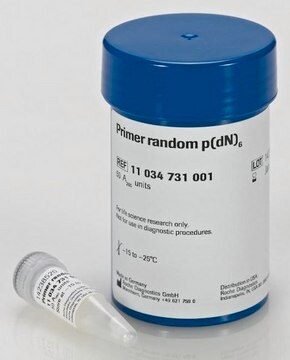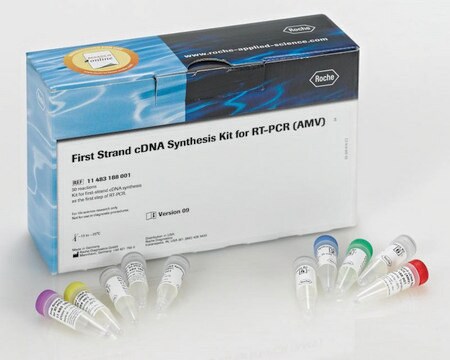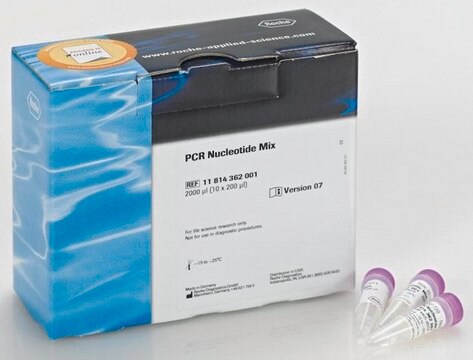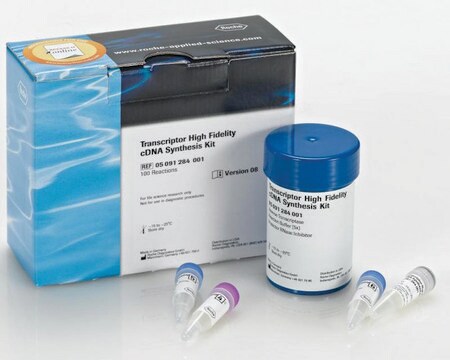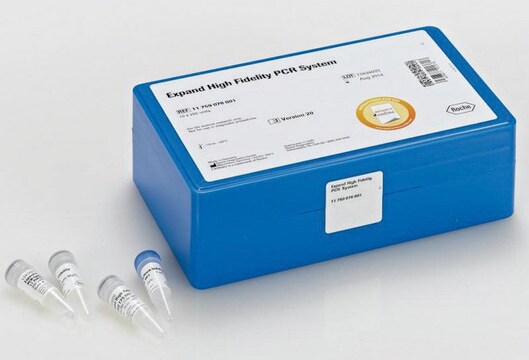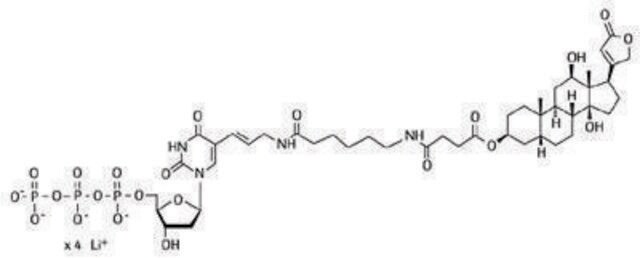11277081001
Roche
Hexanucleotide Mix
solution, pkg of 100 μL, sufficient for 50 labeling reactions
Synonym(s):
nucleotide mix
Sign Into View Organizational & Contract Pricing
All Photos(1)
About This Item
UNSPSC Code:
41106300
Recommended Products
form
solution
Quality Level
usage
sufficient for 50 labeling reactions
packaging
pkg of 100 μL
manufacturer/tradename
Roche
technique(s)
Northern blotting: suitable
Southern blotting: suitable
cDNA synthesis: suitable (first strand)
hybridization: suitable
color
colorless
solubility
water: miscible
storage temp.
−20°C
General description
Convenient oligonucleotide mixture for rapid random-primed labeling of DNA with radioactive, digoxigenin- or biotin-labeled nucleotides. In this method, the complementary DNA strand is synthesized by Klenow polymerase using the 3′-OH termini of the random oligonucleotides as primers.
Specificity
Heat inactivation: Stop the reaction by adding 2 μl 0.2 M EDTA (pH 8.0) and/or by heating to 65 °C for 10 minutes.
Application
Hexanucleotide Mix is a mixture of hexanucleotides of all possible sequences for random-primed DNA labeling.
Labeled DNA probes with high specific activity are used in a variety of hybridization techniques:
Labeled DNA probes with high specific activity are used in a variety of hybridization techniques:
- Screening of gene libraries
- Southern and northern blots
- In situ hybridizations
- RT-PCR
- Generation of cDNA libraries
- Synthesis of first-strand cDNA
- in the determination of vector titer
- Second strand synthesis
Features and Benefits
The product is a 10x concentrated mixture of random hexanucleotides. Statistically, the mix may contain up to 4,096 different hexanucleotides, but these are probably present in differing amounts.
Contents
10x concentrated mixture of hexanucleotides (62.5 A260 units/ml) in reaction buffer [0.5M Tris- HCl, 0.1M MgCl2, 1mM dithioerythritol (DTE), 2mg/ml BSA, pH 7.2 (+20°C)]
Note: The mix is identical to that supplied in vial 5 of the DIG DNA Labeling and Detection Kit and of the DIG DNA Labeling Kit and in vial 6 of the Random Primed DNA Labeling Kit.
Contents
10x concentrated mixture of hexanucleotides (62.5 A260 units/ml) in reaction buffer [0.5M Tris- HCl, 0.1M MgCl2, 1mM dithioerythritol (DTE), 2mg/ml BSA, pH 7.2 (+20°C)]
Note: The mix is identical to that supplied in vial 5 of the DIG DNA Labeling and Detection Kit and of the DIG DNA Labeling Kit and in vial 6 of the Random Primed DNA Labeling Kit.
Quality
Function tested in the Random Primed DNA Labeling Kit.
Principle
The "random primed" DNA labeling method developed by Feinberg and Vogelstein is based on the hybridization of a mixture of all possible hexanucleotides to the DNA to be labeled. All sequence combinations are represented in the hexanucleotide primer mixture, which leads to binding of primer to the template DNA in a statistical manner. Thus, an equal degree of labeling along the entire length of the template DNA is guaranteed. The complementary strand is synthesized from the 3′-OH termini of the random hexanucleotide primer using Klenow enzyme, labeling grade. Modified deoxyribonucleoside triphosphates ([32P], [35S],[3H], or [125I] digoxigenin- or biotin-labeled) present in the reaction are incorporated into the newly synthesized complementary DNA strand.
Preparation Note
Assay Time
Standard labeling (radioactive): 50 minutes
Labeling assay with digoxigenin-11-dUTP: 80 minutes
Sample Materials
Synthesis: All 4 bases are used to synthesize this random hexanucleotide mix. In the initial reaction, starter nucleotides are linked to a solid phase support. In subsequent coupling reactions, equimolar amounts of the 4 dNTPs are linked to the starter nucleotides until hexamers are generated. The hexamers are then released from the solid phase support.
Post-synthesis: The oligonucleotides are HPLC purified, desalted, and 5′-phosphorylated.
Standard labeling (radioactive): 50 minutes
Labeling assay with digoxigenin-11-dUTP: 80 minutes
Sample Materials
- DNA fragments
- Linearized plasmid DNA
- λDNA
Synthesis: All 4 bases are used to synthesize this random hexanucleotide mix. In the initial reaction, starter nucleotides are linked to a solid phase support. In subsequent coupling reactions, equimolar amounts of the 4 dNTPs are linked to the starter nucleotides until hexamers are generated. The hexamers are then released from the solid phase support.
Post-synthesis: The oligonucleotides are HPLC purified, desalted, and 5′-phosphorylated.
Analysis Note
Absorption: 62.5 A260 units correspond to 2.5 mg/ml of hexanucleotides.
Other Notes
For life science research only. Not for use in diagnostic procedures.
Storage Class Code
12 - Non Combustible Liquids
WGK
WGK 1
Flash Point(F)
No data available
Flash Point(C)
No data available
Choose from one of the most recent versions:
Already Own This Product?
Find documentation for the products that you have recently purchased in the Document Library.
Customers Also Viewed
Chen Ling et al.
Journal of visualized experiments : JoVE, (49)(49), doi:10-doi:10 (2011-03-30)
Recombinant vectors based on a non-pathogenic human parvovirus, the adeno-associated virus 2 (AAV2) have been developed, and are currently in use in a number of gene therapy clinical trials. More recently, a number of additional AAV serotypes have also been
Alterations in ribosome biogenesis cause specific defects in C. elegans hermaphrodite gonadogenesis.
Roumen Voutev et al.
Developmental biology, 298(1), 45-58 (2006-08-01)
Ribosome biogenesis is a cell-essential process that influences cell growth, proliferation, and differentiation. How ribosome biogenesis impacts development, however, is poorly understood. Here, we establish a link between ribosome biogenesis and gonadogenesis in Caenorhabditis elegans that affects germline proliferation and
Elise Alspach et al.
Bio-protocol, 5(10) (2015-05-20)
Immunoprecipitation and subsequent isolation of nucleic acids allows for the investigation of protein:nucleic acid interactions. RNA-binding protein immunoprecipitation (RIP) is used for the analysis of protein interactions with mRNA. Combining RIP with quantitative real-time PCR (qRT-PCR) further enhances the RIP
Andrew L Goodman et al.
Nature protocols, 6(12), 1969-1980 (2011-11-19)
Insertion sequencing (INSeq) is a method for determining the insertion site and relative abundance of large numbers of transposon mutants in a mixed population of isogenic mutants of a sequenced microbial species. INSeq is based on a modified mariner transposon
Dilip Kumar et al.
Journal of immunology (Baltimore, Md. : 1950), 182(2), 1011-1020 (2009-01-07)
The MAPKs ERK, JNK, and p38 control diverse aspects of the immune response, including regulation of cytotoxin biology in NK cells and CTL. The chemokine CCL5 is coreleased with the cytotoxins, perforin, the granzymes, and granulysin, during the lethal hit
Our team of scientists has experience in all areas of research including Life Science, Material Science, Chemical Synthesis, Chromatography, Analytical and many others.
Contact Technical Service